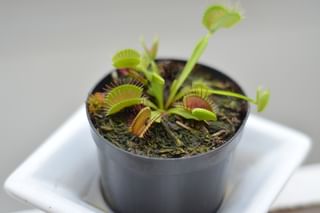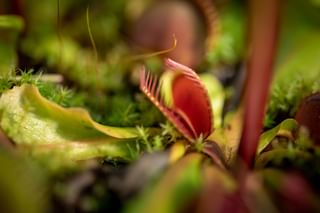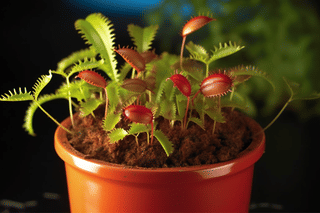How do you take care of a Venus Flytrap?
Learn how to care for your Venus Fly Trap with expert tips and guidance. Discover the secrets to keeping this unique plant happy and thriving. Join me on a journey of plant care, where I share practical advice to help you growing a thriving Venus Fly Trap. Let's unlock the secrets of this incredible plant!
A Venus Flytrap (Dionaea muscipula) isn't your ordinary plant. Its biggest standout feature is its "trap," a jaw-like structure on the ends of its leaves. These traps aren't just for show, they are a sophisticated hunting tool.
Venus Flytraps are, to me, some of the most fascinating plants out there. You hear a lot about plants that filter the air and help you breathe, but these plants help you get rid of bugs. What a good helper this plant turns out to be!
In this comprehensive plant care guide, you'll learn everything you need to know to successfully take care of a Venus Flytrap. It doesn't matter if this is your first time owning a plant, or if you're already an experienced green thumb.
These are the topics we're going to look at:
Let's explore together how we can take care of these fascinating plants to keep them healthy and thriving!
What to know before getting a Venus Flytrap?
Usually, I start my plant care guides by telling you how to care for them, but I'd like to take a moment to help you prepare for getting a Venus Flytrap. Because of their diet, they have different needs than a "normal" plant.
Let's look at the steps you can take to prepare your space for a Venus Flytrap.
What are the ideal environmental conditions for Venus Flytraps?
Venus Flytraps are quite specific about the environment they need to grow. They crave three essential things: light, water, and soil.
- Light: These botanical wonders love bright, indirect light for about 6-8 hours a day. Too little sunlight and your plant will weaken; too much direct sunlight, and it could burn.
- Water: Venus Flytraps enjoy damp soil but are not too saturated. Make sure you use distilled water or rainwater because they are sensitive to minerals typically found in tap water.
- Soil: Venus Flytraps prefer nutrient-poor soils. A good mix would be one part peat moss and one part perlite or sand.
These three aspects are essential to get right if you want your Venus Flytrap to be around for a while. So let's start with these 3 topics before diving into other topics related to taking care of a Venus Flytrap.
How much sunlight does a Venus Flytrap need?
Venus Flytraps are fascinating plants that do more than just beautify your spaces. They're also great little insect catchers! But, to keep them doing their best, you need to provide them with the right amount of sunlight they need.
Venus Flytraps are sun-loving plants, as these plants are native to North and South Carolina in the United States. In their natural habitat, these plants get direct sunlight all day long, so you should find a spot that gives them this type of light.
Ideally, they should get at least 6 to 8 hours of direct sunlight per day. This keeps them healthy and vibrant. If these plants get less sunlight exposure than the 6 hours, they will still be fine, but they may appear weaker, their color may turn pale green and their growth may slow down dramatically.
Can Venus Flytraps survive under artificial lights?
If you don't have enough natural sunlight available, Venus Flytraps can survive under artificial lights. Fluorescent lights or LED grow lights with a color temperature of around 6500K simulating daylight can work well. Just make sure they're positioned about 12 inches or so above the plant.
The watering needs of a Venus Flytrap

The second most important part of taking care of these plants is watering them correctly. In their natural habitat, Venus Flytraps thrive in wetland environments with moist, soggy soil. While they are robust enough to survive brief periods of dryness, long periods without water are not good for these plants.
How often should you water your Venus Flytrap?
So how often should you water these plants that thrive in soggy wetlands? Well, it depends on where you're keeping the Flytrap and the climate conditions. As a general rule, Venus Flytraps should always be moist but not waterlogged.
During warmer months, you might need to water every other day or even daily depending on the plant's location and humidity level. In cool or indoor settings, keep an eye on the soil: if it's almost dry, it's time to water your plant.
What kind of water should you use?
Unlike most houseplants, Venus Flytraps are sensitive to minerals found in the majority of tap and bottled water. Ideal choices are rainwater, distilled water, or reverse-osmosis water. Make sure the water you use is as pure as possible to prevent your Flytrap from getting sick. Remember, over-watering or using the wrong type of water can lead to root rot or mineral buildup, both potentially fatal to your carnivorous plant.
Soil for a Venus Flytrap
When growing Venus Flytraps indoors, the soil's composition is critical in mirroring their natural habitat and ensuring healthy growth. This carnivorous plant thrives best in nutrient-poor soils that mimic the boggy, acidic environments they originally come from.
A well-draining soil mix of one part sphagnum peat moss, one part perlite or coarse sand is ideal. This mix provides the poor nutrition, high acidity, and excellent drainage that Venus Flytraps need. It's important to note that peat moss should be free from added fertilizers or chemicals, which can harm the plant.
In addition to the soil mix, it's important to consider the pot you're going to use. Venus Flytraps have a root system that can grow quite large over time. This is why a deep pot is more suitable than a shallow one, to ensure the roots have enough room to grow. The pot should also have drainage holes to prevent waterlogging and help maintain the right level of moisture in the soil.
Although these plants love water, they also require proper soil aeration to prevent root rot. The goal is to mimic their natural habitat as closely as possible.
Now that we've looked at the most important parts of taking care of a Venus Flytrap, let's look at some other aspects of taking care of this fascinating plant.
Humidity levels for Venus Flytraps
Humidity plays a vital role in the health of a Venus Flytrap. These plants belong to a class of plants called "bog plants," and naturally grow in places with very high humidity. Ideally, the humidity level should be between 50% and 70%. But don't worry if you can't maintain these exact levels. Despite their love for moisture, Venus Flytraps are quite adaptable and can survive in lower humidity.
You can increase the humidity level around your plant by placing a tray of water near it or using a small room humidifier. If the humidity in your home is normally low, consider placing the Venus Flytrap in a terrarium.
Temperature requirements of Venus Flytraps
These plants prefer a moderate temperature, ideally between 18℃ - 35℃ (65℉ - 95℉). They can tolerate short periods of extreme temperatures (both hot and cold) but, for the most part, keeping them at a comfortable room temperature is best. In winter, Venus Flytraps need a rest period known as "dormancy". During this time, it's best to keep them at cooler temperatures, slightly below 15℃ (60℉). This might sound cold, but remember, Venus Flytraps are tough and can handle it. Just be sure to provide enough light during this dormant period, and your plant will perk back up come springtime.
The feeding cycle of the Venus Flytrap
Now, for me, the most interesting part of taking care of a Venus Flytrap: feeding it. I remember looking at this plant for hours to see if it would catch a fly and how it would grow. This is actually how they get their nutrients as well. The nutrient-poor soil doesn't feed the plant, but the insects it catches does.
They have a particular feeding cycle that is closely linked to their growth and dormancy periods. Here's how that cycle goes:
-
Spring to Summer: This is the Venus Flytrap's active growing season. They bloom, open their traps and lure in the bugs they need for food. During this time, you place your plant in a spot with lots of insects. How often you should feed them depends on the insects' availability, but it usually happens once a week or two.
-
Fall to Winter: Known as the dormancy period, during these months your Venus Flytrap needs little to no feeding. The plant typically turns brown and might appear dead - but don't worry, it's part of their cycle and they will come back to life in the spring.
What to feed a Venus Flytrap
Contrary to popular belief, Venus Flytraps don't need to catch flies to survive. They can eat several different types of insects and arachnids, including spiders, beetles, and slugs. If you're keeping your plant indoors and insects are scarce, you can feed them with bloodworms or mealworms to help them survive.
However, don't go overboard with feeding your plant. Feeding your Venus Flytrap too often can cause its health to decline rather than improve. Overfeeding can cause the traps to blacken and die. Feed your Venus Flytrap once every 1 to 2 weeks when it's in its growing season, and not at all during its dormancy period.
If you are feeding your Venus Flytrap yourself, make sure to stick to insects and arachnids and don't feed them anything else. Its digestive system is quite delicate and feeding it anything but insects could disrupt its health.
How to choose a healthy Venus Flytrap?
Now that you know everything you need to know to keep your Venus Flytrap healthy, let's see how you can find a healthy plant to bring home from the local gardening shop.
What are the characteristics of a healthy Venus Flytrap?
Knowing the traits of a healthy VFT is important. Healthy Venus Flytraps tend to exhibit the following signs:
- Green or red leaves: Venus Flytraps come in various colors. So, whether they are green, red, or a mix of both, as long as the color is vibrant, it's a good sign. If the leaves appear to be yellow or brown, it's probably an unhealthy plant.
- Active traps: The trap of this plant is its most distinct feature. A healthy plant should have multiple jaws ready to snap shut on any unsuspecting bugs.
- Firm roots: Check the pot or ask the seller if it's possible to see the roots. They should be white or light-colored and feel firm, not mushy or discolored.
Common problems for a Venus Flytraps
At the beginning of this plant care guide, we looked at the most important aspects of taking care of a Venus Flytrap and there were 3 things: moist soil, direct sunlight, and nutrient-poor soil. So it's no surprise that the biggest problems for a Venus Flytrap come from not providing these three fundamental needs.
These are the biggest issues:
- Inappropriate watering: Too much or too little water can harm your plant. They do best in rainwater or distilled water and like their soil to be kept consistently damp, not waterlogged or dry.
- Lack of sunlight: Venus flytraps are sunbathing plants and need at least 4 hours of direct sunlight. A south-facing window is perfect.
- Wrong soil: They crave nutrient-poor, slightly acidic soil. Sphagnum moss or a mix of moss and sand is ideal.
As long as you stick to these guidelines and you're patient with the plant during the dormancy period, your plant is going to thrive in your house during the spring and summer.
Thank you for reading this post! I hope it helps you to keep your plants healthy and beautiful! If you're looking for more guides on specific plants, you can always request a plant guide to get a guide for the plant you have trouble with.
Test your plant care knowledge
Quiz completed!
Want to learn more? Sign up for my newsletter to receive free tips in your inbox!
Sign up now!









